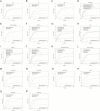Prognosis prediction in esophageal signet-ring-cell carcinoma: a competing risk analysis
- PMID: 37221531
- PMCID: PMC10207763
- DOI: 10.1186/s12876-023-02818-z
Prognosis prediction in esophageal signet-ring-cell carcinoma: a competing risk analysis
Abstract
Objective: This study aims to construct and validate a competing risk nomogram model to predict 1-year, 3-year, and 5-year cancer-specific survival (CSS) for patients with esophageal signet-ring-cell carcinoma.
Methods: Patients diagnosed with esophageal signet-ring-cell carcinoma (ESRCC) between 2010 and 2015 were abstracted from the Surveillance, Epidemiology, and End Results (SEER) database. We performed the competing risk model to select significant variables to build a competing risk nomogram, which was used to estimate 1-year, 3-year, and 5-year CSS probability. The C-index, receiver operating characteristic (ROC) curve, calibration plot, Brier score, and decision curve analysis were performed in the internal validation.
Results: A total of 564 patients with esophageal signet-ring-cell carcinoma fulfilled the eligibility criteria. The competing risk nomogram identified 4 prognostic variables, involving the gender, lung metastases, liver metastases, and receiving surgery. The C indexes of nomogram were 0.61, 0.75, and 0.70, respectively for 5-year, 3-year, and 1-year CSS prediction. The calibration plots displayed high consistency. The Brier scores and decision curve analysis respectively favored good prediction ability and clinical utility of the nomogram.
Conclusions: A competing risk nomogram for esophageal signet-ring-cell carcinoma was successfully constructed and internally validated. This model is expected to predict 1-year, 3-year, and 5-year CSS, and help oncologists and pathologists in clinical decision making and health care management for esophageal signet-ring-cell carcinoma patients.
Keywords: Competing risk nomogram; Esophageal carcinoma; Prognosis prediction; SEER; Signet-ring-cell.
© 2023. The Author(s).
Conflict of interest statement
The authors declare no competing interests.
Figures






Similar articles
-
A prognostic framework for predicting lung signet ring cell carcinoma via a machine learning based cox proportional hazard model.J Cancer Res Clin Oncol. 2024 Jul 25;150(7):364. doi: 10.1007/s00432-024-05886-0. J Cancer Res Clin Oncol. 2024. PMID: 39052087 Free PMC article.
-
A Prognostic Model for Patients With Gastric Signet Ring Cell Carcinoma.Technol Cancer Res Treat. 2021 Jan-Dec;20:15330338211027912. doi: 10.1177/15330338211027912. Technol Cancer Res Treat. 2021. PMID: 34190015 Free PMC article.
-
Clinical features and prognostic factors of esophageal signet ring cell carcinoma: construction and validation of a model based on the SEER database.Transl Cancer Res. 2022 Oct;11(10):3674-3685. doi: 10.21037/tcr-22-1238. Transl Cancer Res. 2022. PMID: 36388034 Free PMC article.
-
A Prognostic Model for Survival in Patients with Gastric Signet Ring Cell Carcinoma.Dig Dis. 2024;42(3):221-229. doi: 10.1159/000536454. Epub 2024 Feb 9. Dig Dis. 2024. PMID: 38342087
-
Nomograms to Predict Overall and Cancer-Specific Survival in Gastric Signet-Ring Cell Carcinoma.J Surg Res. 2021 Oct;266:13-26. doi: 10.1016/j.jss.2021.03.053. Epub 2021 May 9. J Surg Res. 2021. PMID: 33979736
References
MeSH terms
Grants and funding
LinkOut - more resources
Full Text Sources

